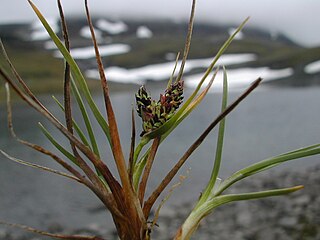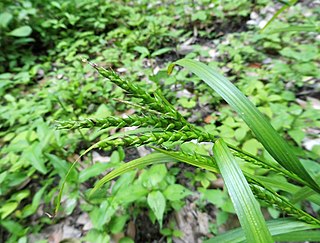
Carex is a vast genus of more than 2,000 species of grass-like plants in the family Cyperaceae, commonly known as sedges. Other members of the family Cyperaceae are also called sedges, however those of genus Carex may be called true sedges, and it is the most species-rich genus in the family. The study of Carex is known as caricology.

Carex chordorrhiza, commonly called creeping sedge or string sedge, is a species of perennial plant in the family Cyperaceae with Holarctic distribution growing in acidic bogs.
Jisaburo Ohwi was Japanese botanist. He was a distinguished member of the Faculty of Science of Kyoto Imperial University. He is perhaps best known for his 1953 Flora of Japan.

Scirpus cyperinus, commonly known as woolgrass, is an emergent wetland herb that is native to the eastern United States and eastern Canada. Other common names include cottongrass bulrush and brown woolly sedge.

Carex sect. Spirostachyae is a section of the genus Carex, containing 38 species of sedge. Species in Carex sect. Spirostachyae share a suite of features, including the short internodes of the primary rhizomes, the presence of an antiligule, the leaf-like, sheathing bract at the base of the inflorescence, the presence of three stigmas in female flowers, and the shape of the seeds.

Carex rufina is a species of sedge known by the common name snowbed sedge. It is native to Denmark, Norway, Sweden, Greenland, and northeastern Canada.

Carex sect. Ovales is a section of the genus Carex, containing around 85 species of sedge. It is the most diverse section of the genus in North America, containing 72 species:

Carex sylvatica is a species of sedge found in deciduous woodlands across Europe. It typically reaches 60 cm (24 in) tall, and has an inflorescence made up of 3–5 pendent female spikes and a single male spike. It is also used as a garden plant, and has been introduced to North America and New Zealand.
Carex aboriginum is a species of sedge endemic to Idaho in the western United States, known as Indian Valley sedge. It was not observed in the wild between 1910, when it was first described, and 1999. Until its rediscovery, C. aboriginum was considered the only plant native to Idaho to have become extinct, and it remains one of the state's rarest and most endangered plant species.

Carex lacustris, known as lake sedge, is a tufted grass-like perennial of the sedge family (Cyperaceae), native to southern Canada and the northern United States. C. lacustris us an herbaceous surface-piercing plant that grows in water up to 50 cm (1.6 ft) deep, and grows 50–150 cm (1.6–4.9 ft) tall. It grows well in marshes and swampy woods of the boreal forest, along river and lake shores, in ditches, marshes, swamps, and other wetland habitat. It grows on muck, sedge peat, wet sand or silt, in filtered or full sunlight.
Carex micropoda is a species of sedge found in temperate and boreal regions of the Northern Hemisphere.
Carex autumnalis is a species of flowering plant in the sedge family, Cyperaceae. It was first formally named by Jisaburo Ohwi in 1930. Carex autumnalis is native to Japan and mainland eastern Asia, from southeastern China to North Korea. In China it grows in shady ravines.
Carex hirtifolia, the pubescent sedge, is a species of sedge native to northeastern North America. It is the only species in Carex section Hirtifoliae. The entire plant is distinctively covered soft hairs.

Carex sect. Macrocephalae is a section of the genus Carex, containing two species. Both are coastal species of sandy areas beside the northern Pacific Ocean – Carex kobomugi from Taiwan to northern China and Japan, and Carex macrocephala from northern China to Oregon.

Carex pumila, commonly known as strand sedge or spreading sedge, is a species of sedge of the family Cyperaceae.

Carex novae-angliae, the New England sedge, is a Carex species that is native to North America.

Carex brevior, known as shortbeak sedge and plains oval sedge, is a species of sedge native to North America. The specific epithet brevior means "shorter" in Latin.

Carex ischnostachya is an herbaceous graminoid plant in the sedge family (Cyperaceae). It is native to the eastern Asia, where it is found in China, Japan, and Korea. Its natural habitat is in forest openings in wet areas, in hills or mountains. It is a common species, and is often found along roadsides or trails.

Carex muehlenbergii is a species of flowering plant, it is a type of sedge. It is a grass-like plant in the family Cyperaceae. Its common names include sand sedge, Muhlenberg's sedge.














